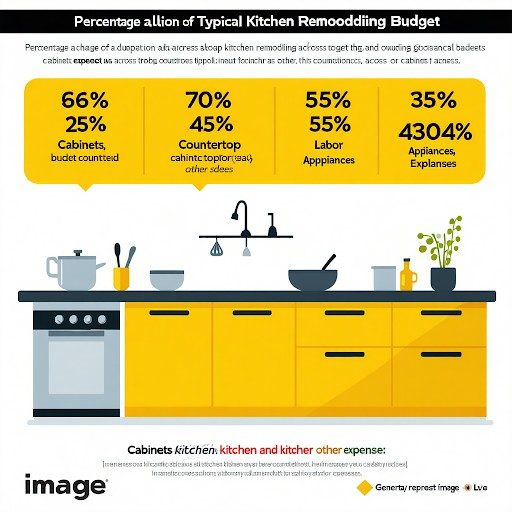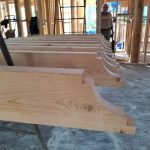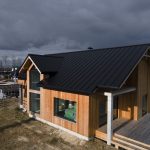Kitchen Remodeling Budget

Understanding the Scope of Your Kitchen Remodeling Project
Planning a kitchen renovation is an exciting journey that can transform the heart of your home into a more functional, beautiful, and valuable space. However, without proper financial planning, that excitement can quickly turn to stress. Creating a realistic kitchen remodeling budget is perhaps the most crucial step in ensuring your project’s success. At Mazzamuto Construction, we’ve guided countless homeowners through the budgeting process, helping them achieve their dream kitchens without unexpected financial surprises.
Before you can create an accurate kitchen remodeling budget, you need to clearly define what you hope to accomplish. The scope of your project will be the primary driver of your overall costs and will help determine which professionals you’ll need to involve.
Defining Your Kitchen Remodeling Goals
Start by asking yourself what’s motivating your remodel. Are you looking to increase your home’s resale value? Create a more functional cooking space? Update outdated aesthetics? Your answers will help guide your budgeting priorities.
Most kitchen remodels fall into one of these categories, each with different budget implications:
- Cosmetic update: Replacing countertops, cabinet fronts, backsplash, and appliances while maintaining the existing layout ($30,000-$60,000)
- Pull and replace: Removing old cabinets and fixtures and replacing them with new ones in the same configuration ($60,000-$100,000)
- Full renovation: Changing the kitchen’s layout, possibly removing walls, relocating plumbing and electrical, and installing all new elements ($100,000+)
A helpful exercise is creating two lists: “must-haves” and “nice-to-haves.” Your must-haves should address the primary reasons for your remodel, while nice-to-haves are elements you can reconsider if your kitchen remodeling budget becomes strained.
Assessing Your Current Kitchen
A thorough assessment of your existing kitchen will help identify potential budget-impacting issues before work begins. This is particularly important in older homes, where outdated electrical systems, plumbing problems, or structural issues might be lurking behind walls.
Remember that building codes have changed significantly over the decades. Older kitchens often need electrical upgrades to support modern appliances and meet current safety standards—a factor that should be accounted for in your kitchen remodeling budget.
Breaking Down Kitchen Remodeling Budget Components
Understanding how costs typically break down for kitchen remodels will help you allocate your budget effectively and identify areas where you might save or splurge.
Major Cost Categories in Kitchen Remodeling
Cabinetry (30-35% of budget)
Cabinets typically represent the largest portion of a kitchen remodeling budget, with costs varying dramatically based on quality, material, and whether you choose stock, semi-custom, or fully custom options:
- Stock cabinets: $100-$300 per linear foot
- Semi-custom cabinets: $200-$550 per linear foot
- Custom cabinets: $500-$1,200+ per linear foot
Cabinet costs also include hardware (pulls and knobs), which can range from $2 to $50+ per piece. For an average kitchen with 30 cabinet doors and drawers, hardware alone can range from $60 to $1,500.
Countertops (10-15%)
Countertop costs vary widely based on material:
- Laminate: $20-$50 per square foot installed
- Solid surface (like Corian): $50-$120 per square foot installed
- Quartz: $70-$150 per square foot installed
- Granite: $60-$200 per square foot installed
- Marble: $75-$250 per square foot installed
The average kitchen contains about 40 square feet of countertop space, making this a significant part of your kitchen remodeling budget.
Appliances (10-20%)
Appliance costs depend entirely on brand, features, and energy efficiency:
- Budget package (refrigerator, range, dishwasher, microwave): $2,000-$5,000
- Mid-range package: $6,000-$12,000
- High-end package: $15,000-$50,000+
Don’t forget to factor in specialized appliances you might want, such as wine refrigerators, warming drawers, or smart appliances.
Installation and Labor (20-35%)
Labor costs vary by region, but in the Bay Area, expect to allocate a substantial portion of your kitchen remodeling budget to quality craftsmanship. This category includes:
- Demolition and removal
- Carpentry
- Plumbing
- Electrical work
- Installation of cabinets, countertops, backsplash, etc.
- Finishing work
Fixtures and Finishes (5-10%)
These elements include:
- Sink(s) and faucets: $250-$2,000+
- Lighting fixtures: $500-$5,000+
- Backsplash: $500-$3,000+
- Flooring: $1,500-$7,000+ depending on material and square footage
- Paint and trim: $800-$2,000
Unexpected Costs and Contingency (10-15%)
Always build a contingency into your kitchen remodeling budget. Unexpected issues like water damage, mold, outdated wiring, or structural problems can arise once walls and cabinets are removed. Having a financial buffer prevents these surprises from derailing your project.
Where to Splurge vs. Where to Save
Creating a balanced kitchen remodeling budget often means making strategic decisions about where to invest and where to economize. Consider following the 80/20 rule: allocate 80% of your visible budget to the 20% of elements that create the most impact.
Worth the Investment:
- Cabinets: You interact with these daily, and they’re the most visible element in your kitchen. If full replacement stretches your budget, consider refacing existing cabinets or using stock cabinets with custom details.
- Countertops: As a focal point and work surface, quality countertops dramatically impact both functionality and aesthetics. Consider splurging on perimeter counters while choosing more budget-friendly options for islands.
- Layout improvements: If your current layout causes daily frustration, prioritizing a better workflow delivers long-term satisfaction and functionality.
- Quality appliances: Focus on reliability and features you’ll actually use rather than brand names. Professional-grade ranges make sense for serious cooks but might be unnecessary for occasional meal preparation.
Areas to Consider Saving:
- Backsplash: Ceramic tile can provide a high-end look at a fraction of the cost of stone or glass.
- Lighting fixtures: Basic recessed lighting with a few statement pendants can provide excellent illumination without breaking your kitchen remodeling budget.
- Flooring: Luxury vinyl plank flooring has become remarkably realistic and offers durability at a fraction of the cost of hardwood or tile.
- Open shelving: Replacing some upper cabinets with shelving can save money while creating a more open, contemporary feel.
Creating Your Detailed Kitchen Remodeling Budget Worksheet
Now that you understand the major components of a kitchen remodeling budget, it’s time to create a detailed plan tailored to your specific project.
Step-by-Step Budget Planning Process
1. Research Current Costs
Prices for materials and labor fluctuate regularly. Take time to research current costs in your area by:
- Visiting home improvement stores and kitchen showrooms
- Getting sample quotes from suppliers
- Using online calculators (while recognizing their limitations)
- Reviewing recently completed projects on contractor websites or platforms like Houzz
2. Get Multiple Quotes
For accurate budgeting, obtain at least three detailed estimates from reputable contractors. Ensure these quotes specify:
- Exactly what materials are included
- The quality/grade of those materials
- What preparation and finishing work is covered
- Timeline expectations
- Payment schedules
- Warranty information
Beware of estimates that seem significantly lower than others—they may exclude important elements of the project or indicate a contractor who might cut corners.
3. Build Your Worksheet
Create a comprehensive kitchen remodeling budget worksheet that tracks:
- Each budget category and subcategory
- Estimated costs based on research and quotes
- Actual costs as they’re incurred
- The difference between estimates and reality
- Notes about decisions or changes
Many homeowners find spreadsheet software ideal for this purpose, allowing easy updates and calculations as the project progresses.
4. Add Contingency Funds
Apply a 15-20% contingency to your total kitchen remodeling budget. For older homes (40+ years), consider increasing this to 20-25% to account for potential hidden issues.
Remember that this contingency isn’t an invitation to upgrade materials mid-project—it’s protection against necessary but unexpected expenses.
Financing Your Kitchen Remodel
With your detailed budget in hand, you’ll need to determine how to finance your project. Common options include:
- Home Equity Loans or Lines of Credit: These typically offer lower interest rates since they’re secured by your home, and in some cases, the interest may be tax-deductible (consult with a tax professional).
- Personal Loans: These unsecured loans may have higher interest rates but don’t put your home at risk and can be obtained relatively quickly.
- Cash: Paying cash eliminates interest costs but depletes savings that might be needed for emergencies.
- Credit Cards: Best reserved for smaller portions of the project or to earn rewards points if you can pay the balance quickly.
- Manufacturer Financing: Some appliance and cabinet companies offer special financing options.
When establishing your payment timeline, consider:
- Most contractors require a deposit (typically 10-30%) before beginning work
- Subsequent payments are usually tied to project milestones
- Final payment should only be made when you’re completely satisfied with the work
Working with Professionals Within Your Budget
Selecting the right professionals and establishing clear communication about your kitchen remodeling budget is essential for success.
Finding the Right Contractor for Your Budget
When interviewing potential contractors, ask these budget-related questions:
- “How do you handle change orders and unexpected costs?”
- “What percentage of your projects come in on budget, and what factors typically cause overruns?”
- “Can you provide references from clients with projects in my budget range?”
- “What suggestions do you have for maximizing value within my budget?”
- “How detailed will your estimate be, and what might not be included?”
Red flags that might indicate future budget problems include:
- Vague or single-page estimates
- Reluctance to discuss potential complications
- Pressuring tactics for quick decisions
- Requesting large upfront payments (more than 30%)
- No clear payment schedule tied to completion milestones
The lowest bid rarely delivers the best value. Look for contractors like Mazzamuto Construction who provide detailed estimates, transparent communication, and a track record of completing projects within budget constraints.
The Contract and Payment Schedule
A well-structured contract protects your kitchen remodeling budget by clearly defining:
- Exactly what work will be performed
- The quality and specifications of all materials
- A detailed timeline with milestones
- The payment schedule
- How changes and additional costs will be handled
- Warranty information
Money-Saving Strategies for Kitchen Remodeling
Even with a generous kitchen remodeling budget, most homeowners appreciate ways to maximize value and potentially reduce costs without sacrificing quality.
Timing Your Remodel for Maximum Savings
Strategic timing can impact your kitchen remodeling budget in several ways:
Seasonal Considerations
- January-March is often slower for contractors, potentially resulting in more competitive pricing
- Avoiding the summer rush can sometimes yield savings of 5-10%
- Appliance purchases timed around major sales events (Black Friday, end of fiscal quarters) can save 10-30%
Project Bundling
Combining your kitchen remodel with other home improvements can create economies of scale. For example, if you’re also updating bathrooms, ordering all cabinets together might qualify for volume discounts.
Phased Approaches
If your full vision exceeds your current budget, consider a phased approach:
- Phase 1: Layout changes, cabinets, plumbing, electrical
- Phase 2: Countertops and backsplash
- Phase 3: New appliances as finances allow
Value Engineering in Kitchen Design
Value engineering isn’t about cutting corners—it’s about making smart substitutions that maintain quality and aesthetics while reducing costs.
Definition and Examples
Value engineering evaluates function versus cost to maximize value. Examples in kitchen remodeling include:
- Using decorative panels on exposed cabinet sides instead of full matching cabinet construction
- Installing stock cabinets but customizing with quality hardware and moldings
- Selecting quartz that mimics marble rather than using actual marble
- Using luxury vinyl plank flooring instead of hardwood
- Creating a statement with an eye-catching backsplash while choosing simpler countertops
Working with Designers
Professional kitchen designers can be valuable partners in maximizing your kitchen remodeling budget. Their expertise allows them to:
- Suggest cost-effective alternatives you might not know about
- Identify elements where quality matters most
- Create visual impact through design rather than expensive materials
- Prevent costly mistakes and unnecessary purchases
Creative Alternatives
Consider these budget-friendly alternatives that deliver similar impact:
- Open shelving instead of all upper cabinets
- Butcher block for island countertops with stone on perimeters
- Extending cabinets to the ceiling for more storage instead of larger footprint
- Lighting to create atmosphere rather than high-end finishes everywhere
- Refacing cabinets instead of replacing them
Balancing Dreams and Dollars in Your Kitchen Renovation
A successful kitchen renovation isn’t simply about having a large budget—it’s about making intelligent choices that align with your priorities and lifestyle. By understanding the full scope of costs, creating a detailed budget with appropriate contingencies, and working with trusted professionals, you can navigate the remodeling process with confidence.
Remember that your kitchen remodeling budget is more than just a spending limit—it’s a strategic tool that helps you allocate resources to create the most impact and value. The most satisfying kitchen renovations aren’t necessarily the most expensive ones, but rather those that thoughtfully balance quality, functionality, and aesthetics within your financial parameters.
Ready to Transform Your Home?
At Mazzamuto Construction, we believe great spaces start with thoughtful planning and skilled craftsmanship. Whether you’re exploring ideas or ready to build, our team is here to guide you every step of the way. Let’s bring your vision home—reach out for a personalized consultation today!
Frequently Asked Questions
1. What is the average cost of a kitchen remodel in the Bay Area?
In the San Francisco Bay Area, kitchen remodeling budgets typically range from $30,000 for basic updates to $150,000+ for high-end renovations. The average mid-range kitchen remodel costs approximately $75,000-$100,000, depending on scope, materials, and location within the Bay Area.
2. How much should I budget for unexpected costs in my kitchen remodel?
Allocate 15-20% of your total budget for unexpected costs. Older homes often require more contingency planning (20-25%) as they may have hidden issues that only become apparent once work begins.
3. Can I save money by doing some of the kitchen remodel work myself?
While DIY work can reduce your budget, be realistic about your skills. Demolition, painting, and simple installations are DIY-friendly. However, plumbing, electrical, and structural work typically require professionals. Mistakes in these areas can be costly and potentially dangerous to fix later.
4. How can I update my kitchen if I have a very limited budget?
With a tight budget, focus on high-impact, low-cost changes like painting cabinets, updating hardware, installing new lighting fixtures, or adding a backsplash. Consider:
- Refinishing existing cabinets ($1,500-$5,000) instead of replacement
- Installing a new faucet ($150-$450) and sink ($250-$1,000)
- Updating lighting with new fixtures ($50-$300 each)
- Adding a fresh coat of paint ($200-$500)
5. How long does a typical kitchen remodel take, and how does timing affect the budget?
Most kitchen remodels take between 4-12 weeks. Extending timelines can increase labor costs and living expenses (like eating out). However, rushing a project might lead to premium charges or mistakes. Material lead times can significantly impact your schedule—some custom cabinets require 8-12 weeks for delivery.
6. Should I choose stock cabinets or custom cabinets for my kitchen remodel?
Stock cabinets can save 30-50% compared to custom options. Semi-custom cabinets offer a middle ground, providing some customization at a moderate price point. Consider your specific needs: if your kitchen has standard dimensions and you’re satisfied with available styles, stock cabinets may be the most budget-friendly choice.
7. How do I know if I need to replace my kitchen’s plumbing and electrical during a remodel?
If your home is over 20 years old, allocate part of your budget for potential updates. Signs you need electrical work include frequent breaker trips, outdated outlets, or inadequate lighting circuits. Plumbing replacement indicators include visible corrosion, low water pressure, or evidence of previous leaks.
8. What are the most cost-effective ways to get high-end looks in my kitchen?
Maximize your budget with strategic choices: consider quartz countertops that mimic marble, vinyl plank flooring instead of hardwood, ready-to-assemble cabinets with premium hardware, or splurge on a statement backsplash while economizing elsewhere. The key is strategic allocation—invest in a few high-impact elements while making economical choices for supporting elements.
Key Takeaways
- Always add a 15-20% buffer to accommodate unexpected issues and changes
- Prioritize spending on elements you interact with daily
- Get at least three detailed quotes to understand the true market rate
- Consider long-term value, not just upfront costs
- Work with professionals who respect your budget constraints
- Document everything and track expenses meticulously




